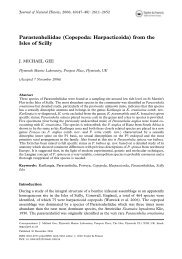An Updated Classification of the Recent Crustacea
An Updated Classification of the Recent Crustacea
An Updated Classification of the Recent Crustacea
Create successful ePaper yourself
Turn your PDF publications into a flip-book with our unique Google optimized e-Paper software.
PREFACE<br />
For anyone with interests in a group <strong>of</strong> organisms<br />
as large and diverse as <strong>the</strong> <strong>Crustacea</strong>, it is difficult<br />
to grasp <strong>the</strong> enormity <strong>of</strong> <strong>the</strong> entire taxon at one<br />
time. Those who work on crustaceans usually specialize<br />
in only one small corner <strong>of</strong> <strong>the</strong> field. Even<br />
though I am sometimes considered a specialist on<br />
crabs, <strong>the</strong> truth is I can pr<strong>of</strong>ess some special knowledge<br />
about only a relatively few species in one or<br />
two families, with forays into o<strong>the</strong>r groups <strong>of</strong> crabs<br />
and o<strong>the</strong>r crustaceans. Crabs are but a small picture<br />
<strong>of</strong> <strong>the</strong> overall diversity <strong>of</strong> <strong>the</strong> <strong>Crustacea</strong>. They represent<br />
only one infraorder [Brachyura] within one<br />
order [Decapoda] within one superorder [Eucarida]<br />
within one subclass [Eumalacostraca] within one<br />
class [Malacostraca] <strong>of</strong> <strong>the</strong> six currently recognized<br />
classes <strong>of</strong> <strong>the</strong> <strong>Crustacea</strong> (as depicted herein). I am<br />
certain that this situation is similar for all o<strong>the</strong>r<br />
crustacean systematists, with <strong>the</strong> result that <strong>the</strong>re<br />
are no living specialists who can truly claim to have<br />
an in-depth understanding <strong>of</strong> <strong>the</strong> <strong>Crustacea</strong> as a<br />
whole.<br />
This volume is an attempt to provide <strong>the</strong> reader,<br />
whe<strong>the</strong>r a seasoned systematist or a beginning student,<br />
with a glimpse into <strong>the</strong> enormous variety <strong>of</strong><br />
extant crustaceans. The sheer number <strong>of</strong> categories<br />
that humans have constructed to contain and order<br />
this group is some indication <strong>of</strong> <strong>the</strong> incredible<br />
amount <strong>of</strong> morphological diversity <strong>the</strong>y exhibit.<br />
But this is only a small part <strong>of</strong> <strong>the</strong> overall picture.<br />
Even if one were to grasp <strong>the</strong> full range <strong>of</strong> taxonomic<br />
diversity as presented in this classification,<br />
such knowledge would shed no light on <strong>the</strong> actual<br />
biology <strong>of</strong> <strong>the</strong>se fascinating animals: <strong>the</strong>ir behavior,<br />
feeding, locomotion, reproduction; <strong>the</strong>ir relationships<br />
to o<strong>the</strong>r organisms; <strong>the</strong>ir adaptations to <strong>the</strong><br />
environment; and o<strong>the</strong>r facets <strong>of</strong> <strong>the</strong>ir existence<br />
that fall under <strong>the</strong> heading <strong>of</strong> biodiversity.<br />
By producing this volume we are attempting to<br />
update an existing classification, produced by Tom<br />
Bowman and Larry Abele (1982), in order to arrange<br />
and update <strong>the</strong> <strong>Crustacea</strong> collection <strong>of</strong> <strong>the</strong><br />
Natural History Museum <strong>of</strong> Los <strong>An</strong>geles County.<br />
This enormous and diverse collection contains an<br />
estimated four to five million specimens, making it<br />
<strong>the</strong> second largest collection <strong>of</strong> <strong>Crustacea</strong> in <strong>the</strong><br />
Americas. While undertaking this task, it occurred<br />
to us that o<strong>the</strong>rs might benefit from our efforts, and<br />
that perhaps a general update on <strong>the</strong> number and<br />
arrangement <strong>of</strong> <strong>the</strong> living crustacean families, along<br />
with an explanation <strong>of</strong> <strong>the</strong> systematic and classificatory<br />
changes suggested during <strong>the</strong> last two decades,<br />
might be a welcome addition to <strong>the</strong> literature.<br />
I hope this volume is seen as nothing more<br />
than <strong>the</strong> briefest <strong>of</strong> introductions into an understanding<br />
<strong>of</strong> crustaceans and that it might lead to<br />
fur<strong>the</strong>r work not only on <strong>the</strong> relationships among<br />
crustaceans but also toward understanding <strong>the</strong><br />
overall picture <strong>of</strong> crustacean biodiversity and natural<br />
history.<br />
Joel W. Martin<br />
June 2001<br />
Los <strong>An</strong>geles, California











